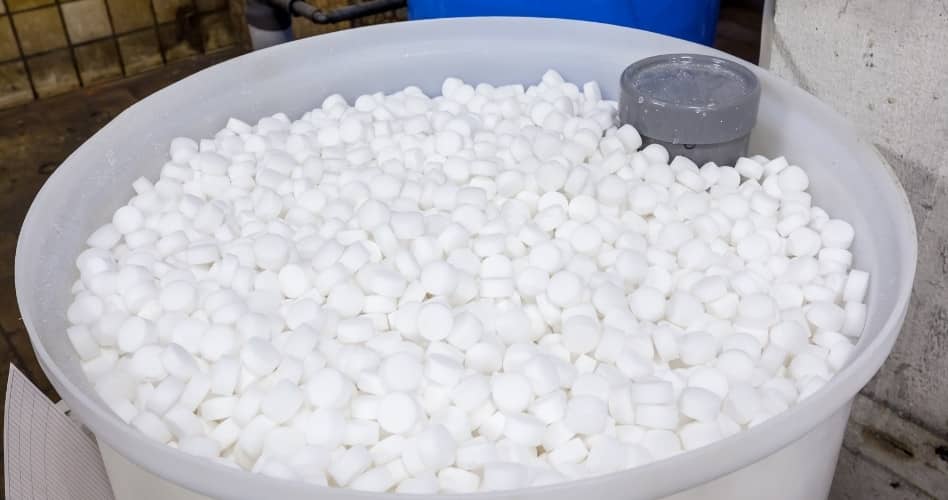
Unfortunately, there are no salt-free water softeners available right now. There is no salt-free water softener. The ion exchange process used by water softeners would not work if the sodium ions weren’t able to push aside the calcium and magnesium ions that are responsible for water hardness. A salt-free water conditioner or scale inhibitor would be a more suitable term to describe products that are frequently sold as salt-free water softeners.
What is a salt-free water conditioner?
A water filtering system that crystallizes the magnesium and calcium minerals present in hard water is known as a salt-free water conditioner. These nanocrystals can’t float out of the solution and cause buildup on pipes and water heaters. Hardness minerals are not physically removed by water conditioners; instead, they are changed and rendered incapable of accumulating as scale buildups. With typical water softeners, a procedure called ion exchange removes the minerals that cause hardness. In an ion exchange procedure, salt solution is used to rinse plastic resin beads, which charges each bead with a sodium ion. The sodium ions exchange with the magnesium and calcium ions as the hard water passes through these beads.
Water softeners have generated significant debate due to the additional salt concentration. In contrast to what is commonly believed, water softeners really add a very small amount of salt to the water. Salt-based softeners also go through periodic regeneration cycles to refill the resin beads with sodium ions. Because of the brine-heavy wastewater that is produced as a result of this, several towns have banned water softeners. A demand for salt-free water softener options has resulted from all of this.
Do Salt-Free Water Softeners Work?
Using an ion exchange technique, saltless water softening system eliminates calcium (Ca2+) and magnesium (Mg2+) from the water. Magnesium and calcium are removed from hard water minerals during the ion exchange process, which is what is meant when the term “water softening” is used.
Contrary to popular belief, salt-free water softening devices cannot effectively remove the minerals found in hard water. Some people think that the only distinction between the two is whether one uses salt or not. In truth, salt-free water softeners just “condition” the water rather than softening it.
Salt-free water softeners employ a physical procedure called Template Assisted Crystallization as opposed to salt-based softeners, which use ion exchange to remove hard water minerals from water (TAC). By this procedure, the hardness minerals in the water are changed into a hardness crystal that won’t adhere to any household surfaces. Water conditioners are another name for salt-free softeners since they condition (or neutralize) the water rather than “softening” it. Also, since these systems don’t trap any materials, a cleaning cycle is not required to get rid of ions that have been trapped.
Advantages of a salt-free water conditioner
Low maintenance
Salt-free water conditioners require extremely little upkeep. As the systems just require a single tank or cartridge, installation is quite easy. Water conditioners don’t require drain connections because they don’t backwash or go through regeneration cycles. They don’t need control valves to monitor flow or start backwashing cycles, nor do they need storage tanks for brine regeneration. They seldom need the services of a plumber and don’t need salt or potassium.
Environmentally friendly
As they don’t go through regeneration cycles, salt-free water conditioners don’t create any effluent. Chlorides are not dumped into the waste stream, which can be difficult for municipal water treatment plants to handle. Also, they conserve water since the tankless heater or your home receives all the water that has been treated by the water conditioner.
Low media consumption
With salt-free water conditioners, the TAC media only has to be changed once every three to five years. Additionally, a complete whole-house water conditioning system may be maintained with very little media. Salt-free tanks don’t require the media to be added to them like water softeners do. The majority of whole-house systems only need 5–10 liters of media to operate for several years.
Disadvantages of a salt-free water conditioner
Unusable on well water
Sadly, well water is the most prevalent source of hard water, making salt-free water conditioners worthless. Iron and manganese levels in well water are quite likely to range from moderate to high. Iron and manganese render water conditioners completely useless. The nucleation sites that produce the hardness micro-crystals are blocked by the iron coating on the TAC medium. With water loaded with iron and manganese, the magnesium and calcium ions will bounce off the anti-scale medium and run into your domestic plumbing, forming scale forms along the way.
No soft water benefits
Nevertheless, these systems do not produce soft water, despite their frequent “salt-free water softener” moniker. The burden of constantly cleaning up after hard water is reduced with soft water. To get merely average results, you will still need to use two times as much dishwashing soap and laundry detergent. Your sinks and bathtubs will still require cleaning to remove soap scum stains. Water conditioners without salt are only partially effective against extremely hard water.
John Richardson
Related posts
Stay connected
- How LoveOn Chat Is Becoming the Most Versatile AI Companion for Digital UsersThe internet keeps shifting toward hyper-personal interaction, and AI companions are at the center of this shift. What used to be simple chatbots are now evolving into emotionally aware, adaptive, and multi-functional digital partners. Among the new generation of platforms, LoveOn Chat is becoming one... The post How LoveOn Chat Is Becoming the Most Versatile […]
